Elsevier Encyclopedia of Geology - vol I A-E
Подождите немного. Документ загружается.

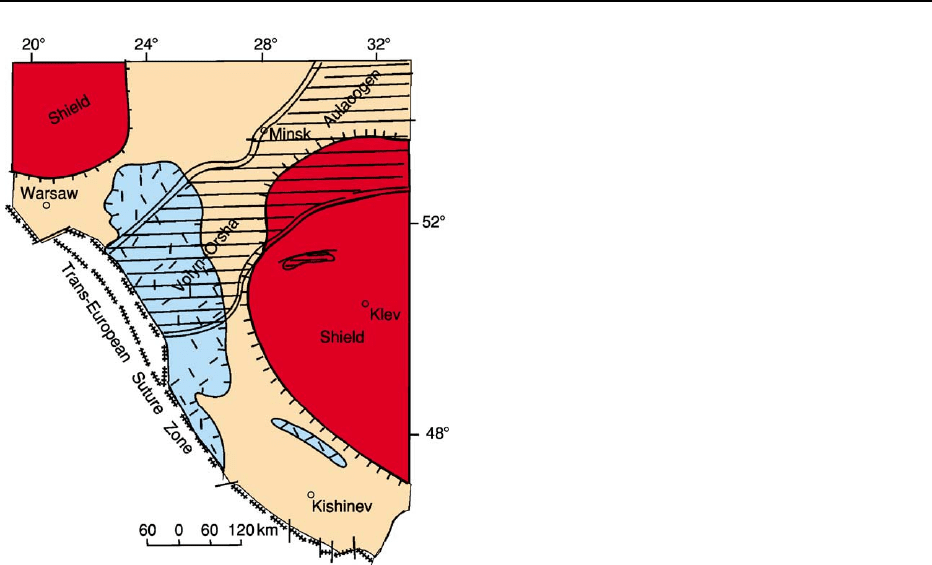
The Belomorian typically features extensive belts of
mafic metavolcanics, continental-margin turbidites,
and TTG-type granitoids, all arranged in large folded
thrust sheets overriding the edge of the Karelian Pro-
tocraton. Thrusting here occurred at about 2.70–
2.65 Ga, when the different terranes and crustal prov-
inces – except possibly the western Archaean pro-
vince – collided and merged to form a Neoarchaean
continent. Concomitantly, parts of the Karelian pro-
vince underwent high-grade metamorphism and mig-
matite formation. Along its boundary with the
Belomorian Belt, 2.7 Ga eclogites are present. Ex-
humation and cooling then followed. Cratonization
became complete at around 2.5 Ga.
Between 2.5 Ga and 2.0 Ga, Archaean Fennoscan-
dia underwent extension, rifting, and even breakup,
leading to the opening of small oceanic basins. Inter-
mittently there was strong dominantly mafic but also
komatiitic igneous activity. Most conspicuous are
large greenstone rifts and belts, which tend to follow
the boundaries between the different Archaean
terranes. Ophiolites with ages of about 1.96 Ga
occur in places.
The latter half of the Palaeoproterozoic was a
period of intense orogenic activity across most of
Fennoscandia. In the north, the Lapland–Kola colli-
sional orogeny at about 1.96–1.85 Ga welded to-
gether the crustal units that constitute the present
Archaean domain. Some of these appear to have
been parts of a Neoarchaean continent that was
broken up in the Early Palaeoproterozoic. In the
case of other crustal units, an exotic provenance has
been suggested. Altogether, the Lapland–Kola Oro-
gen is a tectonic collage of reworked Late Archaean
terranes and intervening belts of Palaeoproterozoic
juvenile crust and turbidites (Figure 10). Prominent
among the latter is the Lapland Granulite Belt, made
famous by Eskola’s work on the facies of metamorph-
ism. Arc magmatism has been dated at 1.96 Ga;
southwards thrusting and collision occurred at
1.91–1.90 Ga, while post-collisional magmatism, ex-
humation, and cooling lasted until 1.85 Ga.
To the south-west of the Archaean domain, the
Proterozoic crust of central Fennoscandia was also
created around and soon after 1.90 Ga in a series of
orogenic events collectively named the Svecofennian
Orogeny. Initial subduction between about 1.93 Ga
and 1.91 Ga appears to have been towards the present
south-west, creating a primitive volcanic arc, but
soon its direction reversed to plunge beneath the
Archaean Protocraton in the north-east.
In simplified outline, the Svecofennian Orogen con-
sists of two volcanic belts and an intervening turbidite
basin (the Bothnian Basin). In south central Finland
there is a very large complex of granitoid plutons. The
northern volcanic belt follows the edge of the
Archaean Protocraton in Scandinavia but then swings
south-eastwards to western and southern Finland,
skirting the complex of granites. The southern belt
extends between southernmost Finland and south cen-
tral Sweden. Continuations of these terranes beyond
Lake Ladoga into Russia are conceivable (Figure 9).
The ages of volcanism in the two belts overlap
within the 1.90–1.88 Ga bracket; dominantly TTG-
type plutonism lasted until about 1.87 Ga. The pres-
sure–temperature ratios of Svecofennian metamorph-
ism were mostly low to moderate, which attests to the
absence of continent–continent collision. Between
them, the two volcanic belts house the majority of
the renowned Finnish and Swedish sulphide and
iron ores. By 1.85 Ga, the Svecofennian Orogen had
been consolidated; however, 1.86–1.84 Ga plutons of
granitoids occur locally at its south-western margin
and along some major intra-orogenic province
boundaries.
Figure 5 The south-western margin of the East European
Craton in the Neoproterozoic. The ruled area shows the Meso-
to Neoproterozoic Volyn–Orsha Aulacogen, which is filled by
mostly terrigenous sedimentary rocks. In the vicinity of the
Trans-European Suture Zone, however, the approximately
550 Ma Volynian flood basalts (blue markings) form a large
outcrop set in Vendian and Early Cambrian sedimentary rocks
(the sand-coloured areas). The basalts fill a basin that trends
across the Aulacogen and runs roughly parallel to the Trans-
European Suture Zone. This indicates that the south-western
margin of the craton was passive at the end of the Neoproterozoic.
ß Svetlana Bogdanova.
40 EUROPE/East European Craton
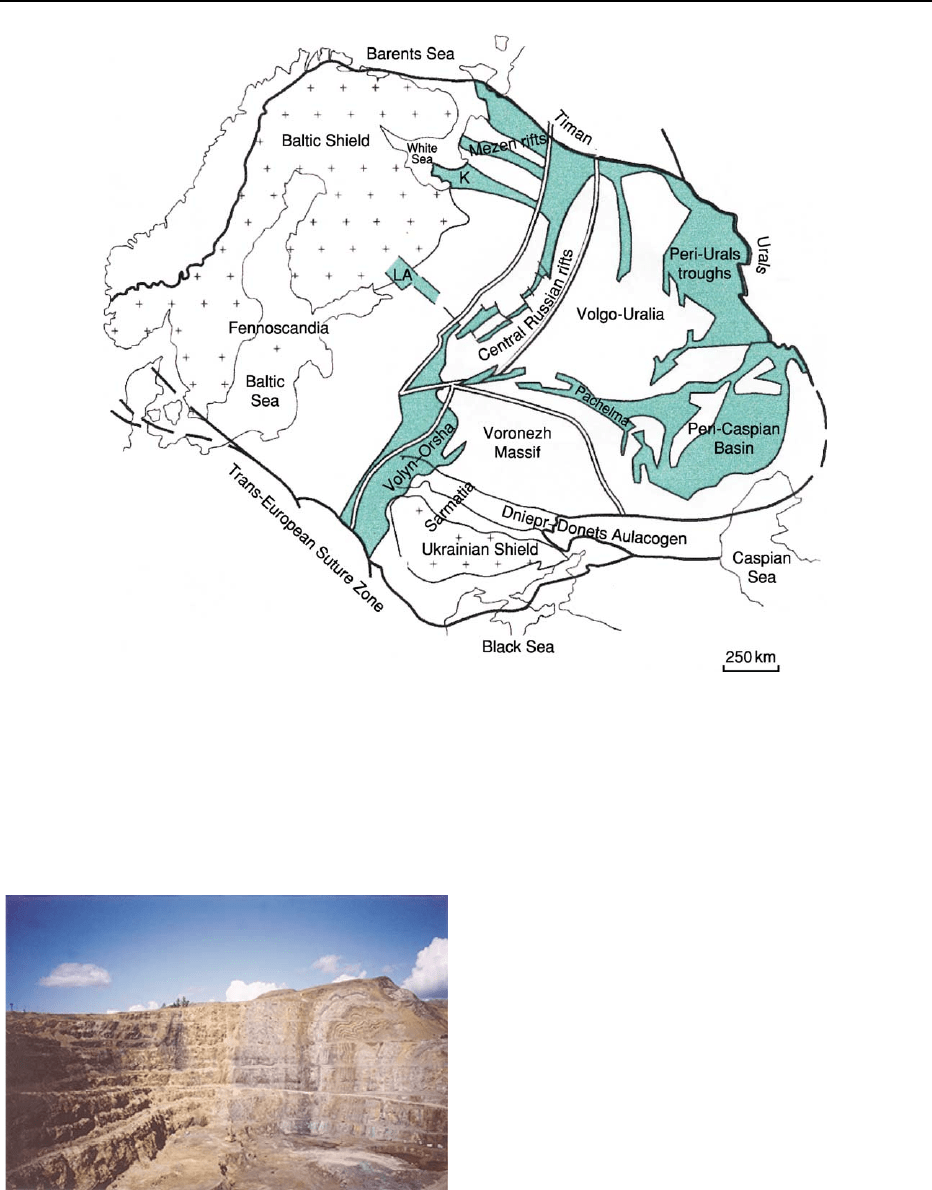
Subsequently, granitic magmatism associated with
metamorphism and migmatite formation but lacking
connection with mafic rocks took place at various
sites and times within the 1.84–1.78 Ga bracket.
Current interpretation sees this as a response to com-
pression and thickening of the Svecofennian crust,
largely caused by orogeny outside the limits of the
Svecofennian domain.
After 1.85 Ga, growth of new crust continued to-
wards the south and the west, outwards from the
cratonized Svecofennian territory. Several accretion-
ary orogenic events at around 1.84–1.83 Ga and
1.81–1.78 Ga, and again during the Gothian Orogeny
at 1.71–1.67 Ga, have been distinguished in a belt
that stretches from Lithuania across southern and
western Sweden to central Norway. Outside the limits
of Svecofennian crust, the granitoid rocks are TTG-
type calc-alkaline, whereas within a marginal western
zone of the Svecofennian Orogen the 1.84–1.67 Ga
Figure 6 The patterns of the Meso- to Neoproterozoic rifts and aulacogens beneath the sedimentary cover of the Russian Platform
conform well with the three-segment fundamental structure of the East European Craton. Thus, the Volyn–Orsha, central Russian, and
Pachelma rifts follow the Palaeoproterozoic sutures between Fennoscandia, Sarmatia, and Volgo-Uralia. The Mezen rifts in the north
align with the Lapland–Kola collisional orogen and delimit the Timanides, while Volgo-Uralia is completely surrounded by troughs,
aulacogens, and the Peri-Caspian Basin. ß Svetlana Bogdanova.
Figure 7 The Mesoproterozoic (Riphean) cover sequence in
the western foreland of the southern Urals was folded in the
Palaeozoic. The sequence is approximately 1500 m thick. Its
components are interbedded conglomerates, sandstones, silt-
stones, pelites, limestones, and dolostones, with numerous de-
posits of siderite ore. The picture shows rocks of the Bakal
Formation in the Irkutskan siderite pit. ß Svetlana Bogdanova.
EUROPE/East European Craton 41
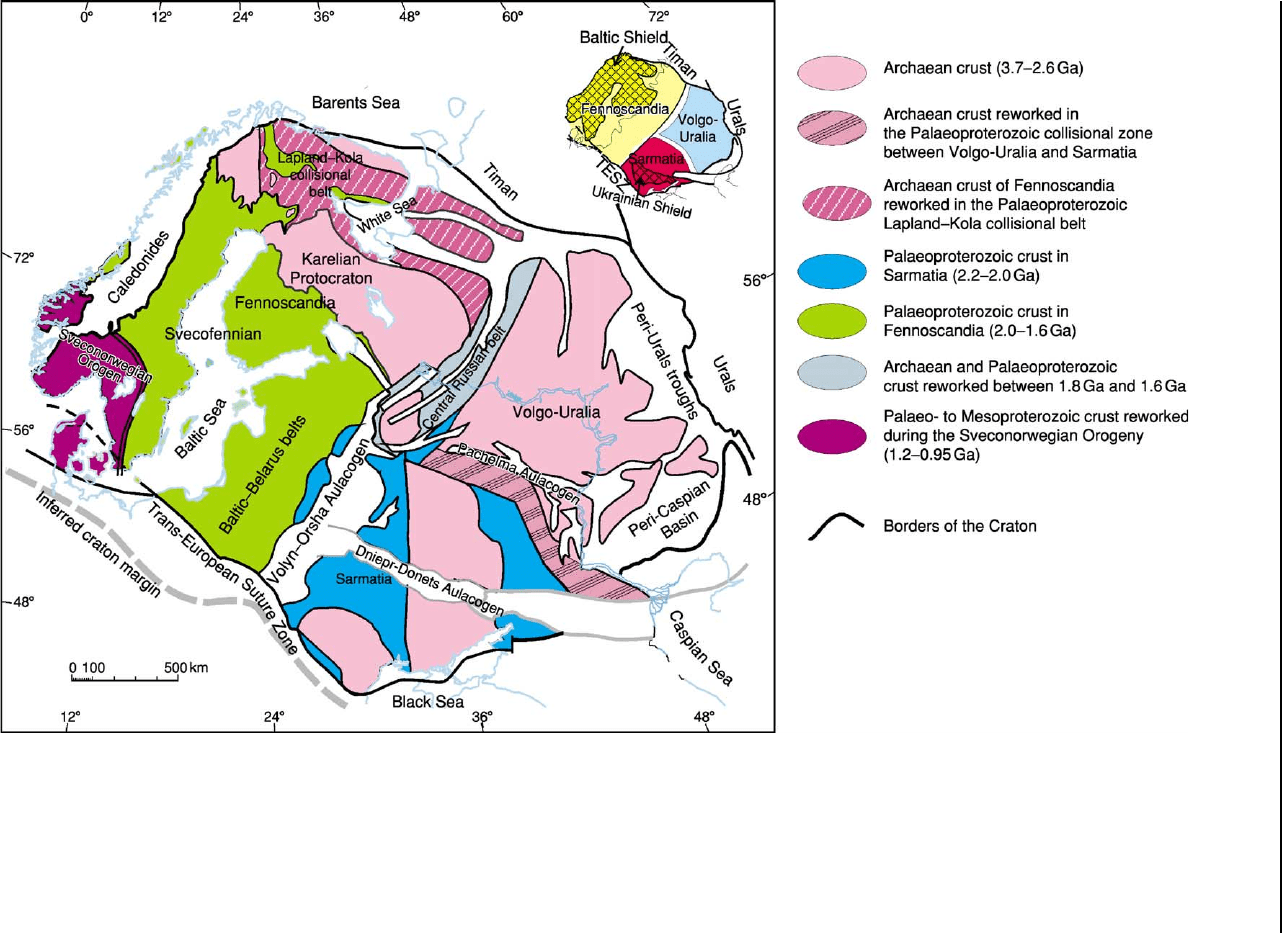
Figure 8 Major crustal provinces of the East European Craton. Apart from Palaeoproterozoic domal structures and some sedimentary and igneous rocks, Volgo-Uralia is almost
completely Archaean. Sarmatia, in contrast, comprises several large Archaean protocratonic units that were cemented together mostly during the Palaeoproterozoic. In Fennoscandia,
Archaean crust is concentrated in the north-eastern part, where it forms a separate domain. Sarmatia and Fennoscandia contain relics of approximately 3.7–3.5 Ga crust, while Volgo-Uralia
is wholly Neoarchaean. Another important difference is that the dominant 2.2–2.0 Ga Palaeoproterozoic crust in Sarmatia is substantially older than the 1.92–1.85 Ga crust of central
Fennoscandia. Thus, the age patterns and structural arrangements in each of the three crustal segments are distinct. They are also largely discordant at the segment boundaries. The
boundary between Sarmatia and Volgo-Uralia is marked by belts of reworked Archaean crust, while the boundary between Fennoscandia and the other two crustal segments is different in
its north-eastern, largely Archaean, and south-western, dominantly Proterozoic, parts. In the north-east, the 200 km wide Central Russian Belt is built up of elongated wedged blocks derived
from the adjacent crustal segments, whereas in the south-west, beneath the Neoproterozoic Volyn–Orsha Aulacogen, there are various Palaeoproterozoic terranes ranging from
continental-margin types to outboard volcanic arcs. These were stacked atop each other between about 1.8 Ga and 1.7 Ga. ß Svetlana Bogdanova.
42 EUROPE/East European Craton
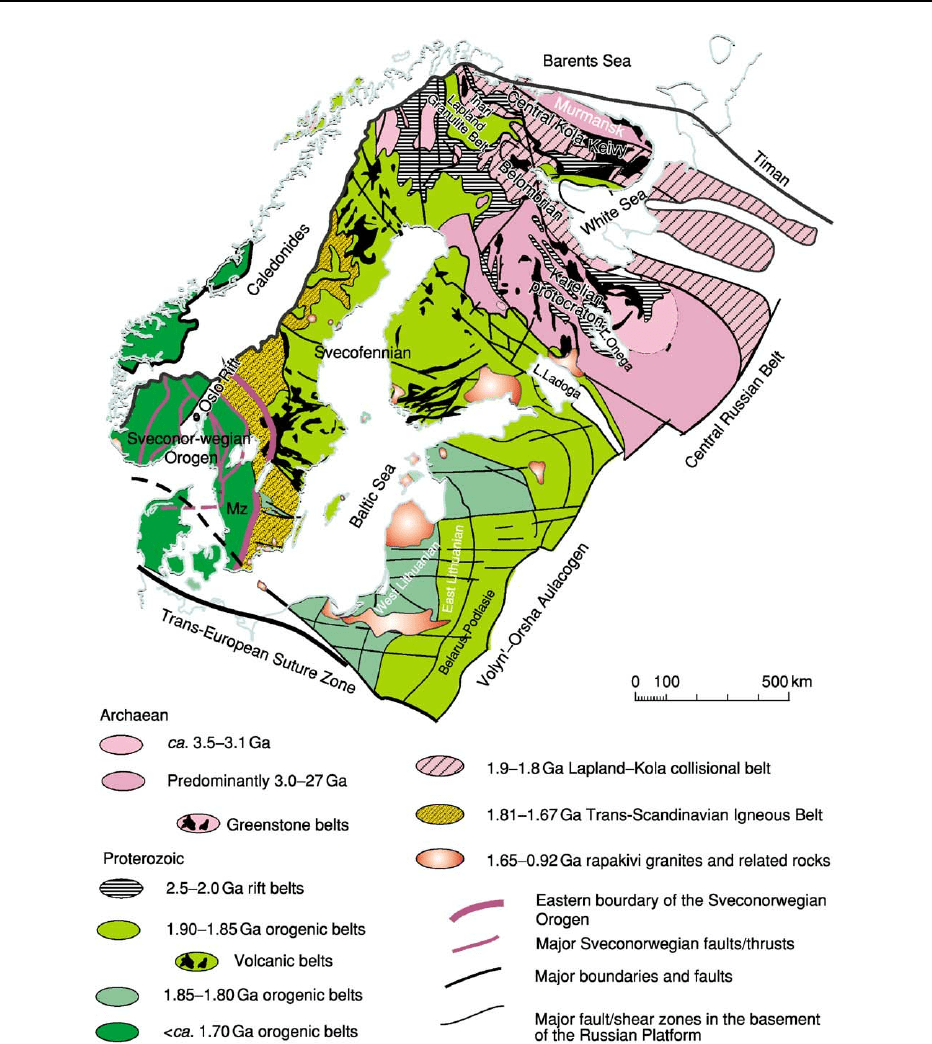
Figure 9 The major crustal provinces of Fennoscandia reflect the subdivision of that crustal segment into largely separate Archaean
and Proterozoic parts. The master story of the Archaean part appears to have been the formation of a Mesoarchaean Protocraton in
Karelia followed by a Neoarchaean continent. The latter was broken up in the Early Palaeoproterozoic but then brought together again
during the Lapland–Kola collisional Orogeny. In that process, Archaean terranes exotic to Fennoscandia may also have participated.
Essentially coeval with the Palaeoproterozoic Lapland–Kola collision in the present north was the first stage of the accretionary
formation of Proterozoic crust in the rest of the Fennoscandian crustal segment. In the present west, this process continued
episodically until about 1.55–1.50 Ga, apparently without involving major collisions of continental crustal units. In the south-west,
continental collision is indicated for the period between 1.5 Ga and 1.4 Ga, when interaction with a different craton – possibly Proto-
Amazonia – appears to have led to the Danopolonian Orogeny. The subsequent Sveconorwegian orogenic process, between about
1.1 Ga and 0.95 Ga, was pronouncedly collisional and approximately coeval with the Grenvillian Orogeny in Laurentia and the
assembly of the Supercontinent Rodinia. Along the south-eastern margin of Fennoscandia, the wide Baltic–Belarus belts of stacked
inboard and outboard terranes mark the Late Palaeoproterozoic (
ca. 1.8–1.7 Ga) collision zone with Sarmatia. Here, the West
Lithuanian Belt and its continuation into south-eastern Poland differ sharply from the adjacent East Lithuanian and Belarus–Podlasie
belts in terms of both the direction of the tectonic grain and the age of crustal formation. In western Lithuania, the crust is nearly coeval
with that in south-western Sweden. Mz, Mylonite Zone. ß Svetlana Bogdanova.
EUROPE/East European Craton 43
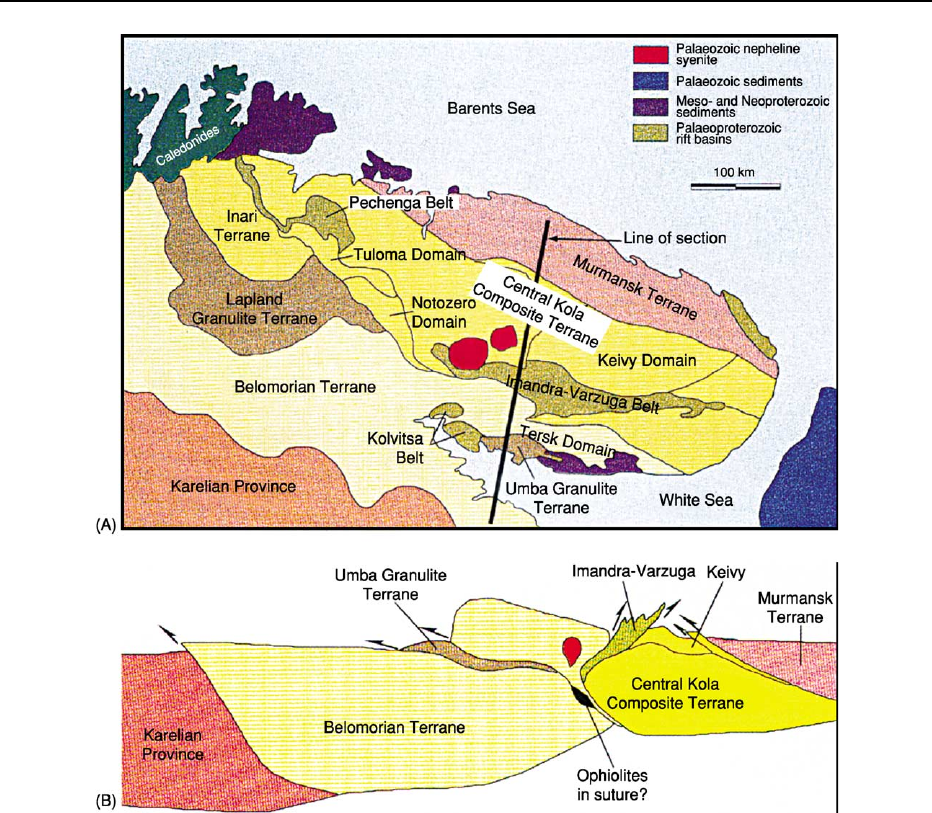
magmatism was bimodal mafic to granitic and
commonly alkali-calcic. As a cumulative result of
the different igneous episodes, the large north–south
trending Transscandinavian Igneous Belt was formed
within the western margin (Figure 9). The Baltic–
Belarus belts, some of them with a Palaeoproterozoic
evolution similar to that of the Svecofennian in the
Baltic Shield, characterize the south-western part
of Fennoscandia; they are, however, overlain by
phanerozoic sedimentary cover (Figure 3A).
During the Mesoproterozoic, renewed Orogeny
between 1.6 Ga and 1.5 Ga created new crust in west-
ernmost Sweden and southern Norway (the Kongsber-
gian event), etc. In contrast, orogenic events around
1.5–1.4 Ga (the Danopolonian Orogeny) and between
1.1 Ga and 0.9 Ga (the Sveconorwegian Orogeny) were
largely collisional. The Sveconorwegian Orogeny
involved only limited creation of new crust in south-
western Norway but fairly voluminous granitic mag-
matism and granulitic to eclogitic metamorphism
with migmatization in many places. Some of the
metamorphic assemblages indicate pressures between
1 GPa and 1.5 GPa. High-grade granulitic rocks
accompanied by charnockite, and numerous large
granite bodies were also formed at around 1.4 Ga.
During both these events, major more-or-less north–
south-trending faults, thrusts, and suture zones were
developed in most of southern Scandinavia.
According to some hypotheses, all of southern
Norway and western Sweden west of the so-called
‘Mylonite Zone’ (Figure 9) constitute terranes exotic
to Fennoscandia, which were accreted to the East
European Craton during the Sveconorwegian
Orogeny.
Figure 10 (A) Tectonics of the Lapland–Kola collisional belt in the Kola Peninsula. (Map supplied by the Secretariat of the
EUROPROBE Programme). (B) Cross-section showing the juxtaposition of various Archaean terranes (the Karelian, Belomorian,
Murmansk, and Central Kola–Keivy) with the Palaeoproterozoic Imandra–Varzuga volcanic belt and the Umba Granulite Terrane. Map
and cross-section by courtesy of the Secretariat of the EUROPROBE Programme.
44 EUROPE/East European Craton
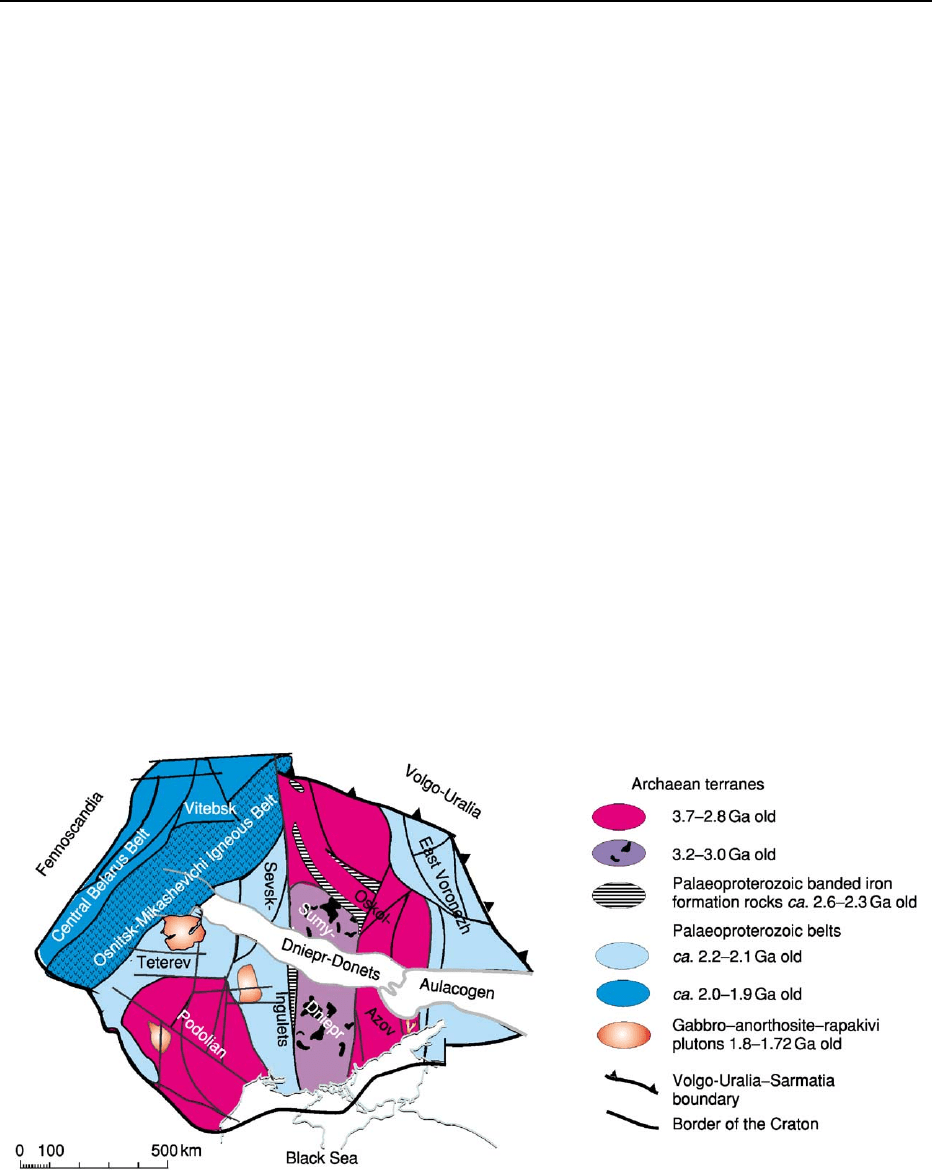
At about 1.64–1.62 Ga, and again at 1.57 Ga,
around 1.5 Ga, and 0.93 Ga, numerous large intru-
sions of rapakivi granites and associated charnocki-
tic, mangeritic, and anorthositic rocks penetrated the
Fennoscandian crustal segment. Extensive swarms of
mafic dykes and sheets were formed throughout the
Proterozoic, with maxima at 2.45–2.1 Ga, 1.6–
1.5 Ga, and 1.3–1.2 Ga and 0.97–0.95 Ga. Some of
these may be the results of superplume events in the
Earth’s mantle. In addition there are plugs and
plutons of alkaline and carbonatitic rocks (see Igne-
ous Rocks: Carbonatites), some of which are Precam-
brian and others Phanerozoic in age. Alkaline
magmatism was particularly voluminous in the Kola
Peninsula and along rifts such as the Permian Oslo
Graben in Norway. Other intrusions formed isolated
minor plugs.
Sarmatia
The Sarmatian segment is built up of several Ar-
chaean crustal provinces with ages ranging between
3.7 Ga and 2.7 Ga (Figure 11). Belts of Palaeoproter-
ozoic crust intervene between some of these, but
accretion and welding appear to have commenced in
the Archaean.
The oldest crustal units are the Palaeo- to
Mesoarchaean Podolian Block in the extreme south-
west and the Oskol (Kursk-)–Azov Block in the east.
Ages of 3.65–3.60 Ga have been obtained from
ultramafic and tonalitic rocks, while major TTG in-
trusions are 3.4–3.3 Ga old. Both the Podolian Block
and the Oskol–Azov Block represent one-time lower
crust but have evolved through several events of
high-grade granulitic metamorphism and multiphase
magmatism in the Archaean and Palaeoproterozoic.
The Sumy–Dniepr gneiss–granite–greenstone ter-
rane is generally somewhat younger. It was formed
mainly between 3.2 Ga and 3.1 Ga and is characterized
by numerous belts of principally mafic metavolcanic
and sedimentary rocks. These contain basal sequences
of komatiites, komatiitic basalts, and tholeiites, reach-
ing thicknesses of 4–5 km. Atop the mafic volcanics rest
calc-alkaline felsic volcanic rocks, tuffites, immature
sandy metasediments, and banded iron formations
with quartzites. These belts were metamorphosed and
deformed concomitantly with the development of
domal structures containing juvenile TTG-type grani-
toids and felsic gneisses with granulites. The alteration
processes were related either to rifting and the opening
of a Mesoarchaean ocean or to the evolution of a pre-
existing oceanic basin of Palaeo- to Mesoarchaean age.
In the Palaeoproterozoic, between about 2.6 Ga
and 2.3 Ga, major belts of supracrustal rocks contain-
ing numerous banded iron formations were formed.
Some of these outline the margins of Archaean
terranes, while others appear to be controlled by
rifts in the interior parts of the Oskol–Azov Block.
The latter are the cause of the strong Kursk magnetic
Figure 11 The processes that shaped the internal structure of Sarmatia were the docking of the older Archaean Oskol–Azov and the
younger Archaean Sumy–Dniepr crustal blocks and, during the Proterozoic, the accretion of the Podolian Block to the evolving main
mass of the Sarmatian crustal segment. The latter process was coeval with the generation of mantle-derived juvenile Proterozoic crust
elsewhere in Sarmatia. Directly related to the assembly of the East European Craton were the formation of the East Voronezh belts
along the developing boundary between Sarmatia and Volgo-Uralia about 2.1–2.0 Ga ago and the formation of the continental-margin
Osnitsk–Mikashevichi Igneous Belt and the outboard Central Belarus Belt at around 2.0 Ga. These two belts faced the ocean basin that
was consumed during the collision of united Volgo-Uralia and Sarmatia (i.e. ‘Volgo-Sarmatia’) with Fennoscandia. ß Svetlana
Bogdanova.
EUROPE/East European Craton 45

anomaly that marks an important iron-ore province.
At about the time that these rock belts were
formed, an ancient platform cover began to be de-
posited. The largest sedimentary basin was in the
Sevsk-Ingulets (Kirovograd) domain.
In north-western Sarmatia, some Palaeoprotero-
zoic volcanic rocks, e.g. those in the Teterev Belt,
have mantle-related geochemical signatures and
probably represent island arcs. The most conspicuous
complexes of juvenile igneous rocks, however, are
found in the East Voronezh belts in eastern Sarmatia,
where an approximately 2.1 Ga volcanic arc and
back-arc sedimentary basins with numerous ultrama-
fic and mafic intrusions occur. Together with numer-
ous granitoid intrusions of the same age along the
edge of the Archaean Oskol–Azov Block, these indi-
cate the presence of an ocean–continent interface. At
this time Sarmatia was assembled and its dominant
north–south-trending suture zones were created.
These have crustal roots approximately 60 km deep.
Along the north-western margin of Sarmatia, the
Early Palaeoproterozoic north–south fabric is trun-
cated by several wide north-east-trending belts of
Late Palaeoproterozoic rocks. These are the
Osnitsk–Mikashevichi Igneous Belt, the Central Bela-
rus Belt, and the Vitebsk granulite domain (Figure
11), all of which were formed between 2.0 Ga and
1.9 Ga, a top south-eastwards dipping subduction
zones or zones of arc collision.
In particular, the presence of the extensive Osnitsk–
Mikashevichi Igneous Belt suggests the existence at
around 2.0 Ga of a unified Sarmatia, complete with a
coherent north-western to northern margin. The
Osnitsk–Mikashvichi Igneous Belt is 200–250 km
wide and comprises volcanic, hypabyssal, and dom-
inantly plutonic igneous rocks. The volcanic and dyke
rocks are metabasalts and dolerites, meta-andesites,
and meta-keratophyres, all metamorphosed in vari-
ous ranges of the amphibolite facies. Granodiorites
and granites with subordinate gabbros and diorites
form large batholithic plutons, which are only weakly
deformed and metamorphosed. The metavolcanics
and minor interbedded metasedimentary rocks
occupy small areas within the plutons or form septa
between them.
A striking feature in Sarmatia is the occurrence of
several large plutons of gabbro-anorthosites and
rapakivi granites of 1.80–1.72 Ga age that are rich
in titanium and other ore deposits. Traditionally,
these intracratonic plutons have been considered to
be anorogenic, but recent discussion tends to connect
them with zones of preceding plate collision. New
seismic results indicate that the anorthosite–rapakivi
magmatism strongly influenced the composition of
both the crust and the upper mantle.
In the Devonian, the formation of the Dniepr–
Donets Aulacogen subdivided the Sarmatian crustal
segment into two parts. The southern part contains
the Ukrainian Shield, and the northern part contains
the Voronezh Massif. However, no significant dis-
placement along the aulacogen can have taken place,
since the terrains on each side correlate excellently.
Volgo-Uralia
The crystalline crust of Volgo-Uralia is mostly
Neoarchaean, the highest depleted-mantle Nd model
ages being approximately 3.1 Ga. This crust is com-
pletely buried beneath a Phanerozoic, mostly Devon-
ian to Triassic, sedimentary cover. The only exception
is the Taratash complex (Figure 12), where a base-
ment slice was brought up to the Earth’s surface by
thrusting connected with the Uralide Orogeny.
Under the Phanerozoic cover, however, there are
numerous Meso- to Neoproterozoic aulacogens and
troughs filled with 2–10 km thick sedimentary rocks
intercalated with rare volcanics. Proterozoic rifting
substantially complicated the margins of Volgo-Ura-
lia and penetrated deeply into its interior. Because of
the extensive cover, information on the crystalline
crust is mostly derived from geophysics and from
thousands of drill cores, which are particularly
numerous because of the high oil and gas potential
of the region.
Volgo-Uralia in general is a realm of high magnetiza-
tion and dense upper crust. A characteristic feature of
its magnetic field is the presence of numerous, in part
very large (300 km and more), circular to oval concen-
tric anomalies separated by wide belts of more or less
linear anomaly patterns. Traditionally, such patterns
have been explained by assuming that the non-linear
nearly isometric anomalies represent stable Archaean
massifs, while the linear zones relate to Palaeoproter-
ozoic mobile belts. In Volgo-Uralia, however, this inter-
pretation is at complete variance with the presently
available geological information, which demonstrates
that the circular anomalies represent Palaeoproterozoic
domal, relatively uplifted, structures. In contrast, the
linear belts consist of relatively well-preserved Ar-
chaean rocks. These are 3.0–2.7 Ga old and comprise
metasedimentary and subordinate metaigneous granu-
lites, these two types mostly forming separate belts. In
addition, there are also greenstone sequences with
komatiitic volcanics. Associated with the Archaean
belts are zones of strong shearing and mylonitization
defining fold–thrust structures and generally trending
north-east–south-west to east–west.
Most of the domes in the Volga–Kama megablock
(Figure 12) are made up of Archaean granulites
reworked during the Palaeoproterozoic. In their
46 EUROPE/East European Craton
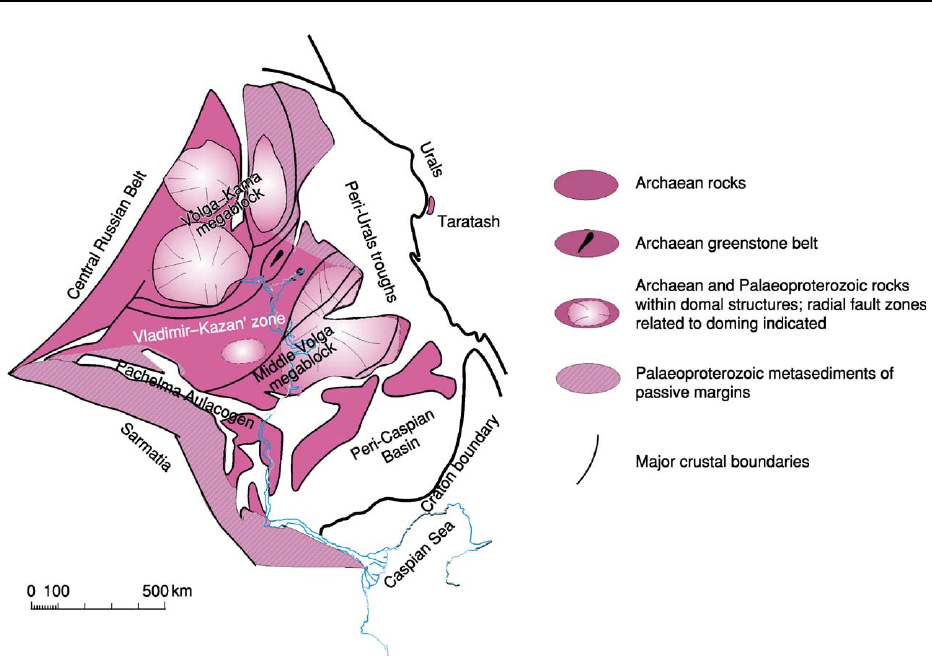
central parts are Palaeoproterozoic granite and gneiss
complexes. In contrast, the very large circular struc-
ture in the Middle Volga megablock has Palaeo-
proterozoic rocks and Palaeoproterozoic reworking
on its flanks, while north-east–south-west striking
Archaean granulites similar to those outside the
dome occupy the centre.
All the domes feature radial and ring-shaped faults
related to the deformation of the Archaean crust and
associated with rare Palaeoproterozoic metasedimen-
tary and metavolcanic rocks. The domes were formed
between 2.3 and 2.0 Ga and may be related to the
nearly coeval collision of Volgo-Uralia with Sarmatia.
Along that collision zone and in the north-east of
Volgo-Uralia there are large areas of Palaeoprotero-
zoic turbiditic and metapelitic mica schists, silts,
sandstones, and carbonaceous shales formed on the
shelf margins of the crustal segment.
The Archaean and Palaeoproterozoic rocks of
Volgo-Uralia are cut by numerous mafic dykes and
sills, which were intruded during several stages of
Meso- to Neoproterozoic rifting.
The Proterozoic fault systems of Volgo-Uralia
strongly influenced the formation and structure of
the sedimentary cover and the locations of the major
Palaeozoic oil and gas resources.
Assembly of the East European Craton
The assembly of the East European Craton can be
followed from palaeomagnetic data, isotopic ages,
and analyses of rock formation and igneous activity
at the margins of the three involved crustal segments
(Figure 13).
First to collide were Volgo-Uralia and Sarmatia.
The collision occurred at 2.1–2.05 Ga, when Volgo-
Uralia was thrust onto Sarmatia. Geophysically, the
suture can be followed for 30 km beneath Volgo-
Uralia. At the Earth’s surface, the junction zone con-
tains extensive shelf deposits on the Volgo-Uralian
Figure 12 The specifics of Volgo-Uralia were largely determined by the development of Palaeoproterozoic domal structures in the
Neoarchaean continental crust. At about 2.1–2.0 Ga, the marginal belt facing Sarmatia was formed. This belt is composed of
Palaeoproterozoic sedimentary commonly flysh-like rocks, which suggest the one-time existence of a passive margin. Subsequent
Mesoproterozoic rifting and the formation of troughs, aulacogens, and basins influenced the structure of Volgo-Uralia more than that of
the other two East European crustal segments. The Peri-Caspian Basin is unique in the East European Craton in having a relatively
shallow Moho and a great thickness of sedimentary cover. ß Svetlana Bogdanova.
EUROPE/East European Craton 47
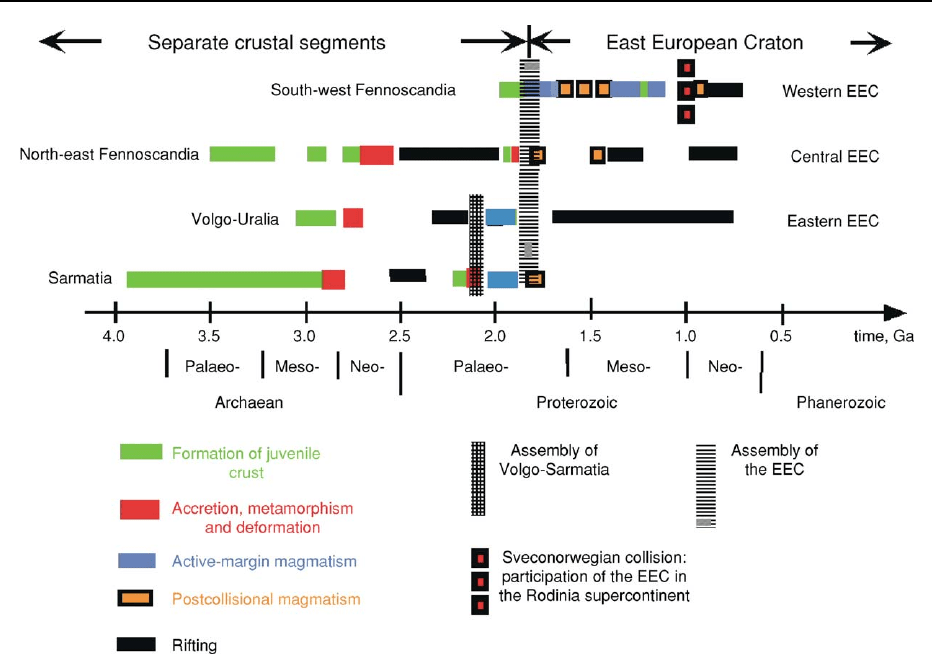
side, while the so-called East Voronezh belts mark the
edge of Sarmatia.
The south-westernmost belt represents a volcanic
island arc, while the north-eastern belts preserve
back-arc volcanic rocks and turbidites. Voluminous
granitic magmatism occurred particularly in Volgo-
Uralia. During the Mesoproterozoic, the Pachelma
Aulacogen developed along the Sarmatia–Volgo-
Uralia junction.
After that collision, it was several hundred million
years before the combined Sarmatia and Volgo-Uralia
(‘Volgo-Sarmatia’) approached Fennoscandia. Mean-
while, accretionary crustal growth occurred separ-
ately along the edges of both Fennoscandia and
Sarmatia. At approximately 2.0 Ga, subduction of
oceanic crust beneath the presently north-western
edge of Volgo-Sarmatia commenced. This process
eventually consumed all the oceanic crust between
the protocraton and Fennoscandia. Within the
continental margin of Sarmatia, the Osnitsk–
Mikashevichi Belt began to develop, while the
Central Belarus island arcs were formed outboard.
Further west, the Middle Lithuanian Suture Zone,
separating east–west trending rocks of the West
Lithuanian Terrane from a belt of north-north-east-
striking rocks in eastern Lithuania, was created. It
may either coincide with the actual Fennoscandia–
Sarmatia suture or be one of several components
within a swarm of intersegment terrane boundaries.
Palaeomagnetic data indicate that the colliding seg-
ments were still at least 2000 km apart between
1.80 Ga and 1.75 Ga.
The Palaeoproterozoic suture between Fennoscan-
dia and Volgo-Sarmatia became the site where the
Volyn–Orsha and central Russian systems of aulaco-
gens, rifts and troughs, and sedimentary basins
were developed in the Late Mesoproterozoic and
Early Neoproterozoic.
See Also
Europe: Timanides of Northern Russia; Scandinavian Ca-
ledonides (with Greenland); The Urals. Igneous Rocks:
Figure 13 Fennoscandia, Sarmatia, and Volgo-Uralia, the three crustal segments of the East European Craton (EEC), evolved
differently during the Archaean and Palaeoproterozoic. Sarmatia and Volgo-Uralia merged at around 2.1–2.0 Ga, creating a larger
continental unit, Volgo-Sarmatia, and thereafter shared a common history. Between about 1.8 Ga and 1.7 Ga, Fennoscandia and Volgo-
Sarmatia gradually amalgamated to form the EEC. The eastern and western margins of the EEC differed during the rest of the
Proterozoic: mostly passive in the east and with episodes of activity in the west. In the west, the ca. 1.0 Ga Sveconorwegian collisional
orogeny marks the beginning of the participation of the EEC in the Supercontinent Rodinia. ß Svetlana Bogdanova.
48 EUROPE/East European Craton

Carbonatites; Kimberlite; Komatiite. Shields. Tectonics:
Mountain Building and Orogeny.
Further Reading
Bogdanova SV (1986) Zemnaya Kora Russkoy Plity v Ran-
nem Dokembrii [The Earth’s Crust of the Russian Plat-
form in the Early Precambrian]. Transactions of the
Geological Institute of the USSR Academy of Sciences,
vol. 408. Moscow: Nauka. [In Russian.]
Bogdanova S, Gorbatschev R, Stephenson RA, and Guterch
A (eds.) (2001) EUROBRIDGE: Palaeoproterozoic accre-
tion of Fennoscandia and Sarmatia. Tectonophysics 339:
1–237.
Gaa
´
l G and Gorbatschev R (1987) An outline of the Pre-
cambrian evolution of the Baltic Shield. Precambrian
Research 35: 15–52.
Gee DG and Zeyen HJ (eds.) (1996) EUROPROBE 1996,
Lithosphere Dynamics: Origin and Evolution of Con-
tinents. Published by the EUROPROBE Secretariate,
Uppsala University, p. 138.
Glebovitsky VA (1997) Early Precambrian of Russia.
London: Taylor and Francis Books Ltd.
Gorbatschev R and Bogdanova S (1993) Frontiers in the
Baltic Shield. Precambrian Research 64: 3–21.
Gower CF, Rivers T, and Ryan B (eds.) (1990) Mid-
Proterozoic Laurentia–Baltica. Special Paper 38. St Johns:
Geological Association of Canada.
Khain VE (1985) Geology of the USSR. First Part:
Old Cratons and Paleozoic Fold Belts. Berlin: Gebru
¨
der
Borntraeger.
Koistinen T, Stephens MB, Bogachev V, et al. (2001) Geo-
logical Map of the Fennoscandian Shield, Scale
1 : 2 000 000. Moscow: Geological Surveys of Finland,
Norway, and Sweden and North-West Department of
Natural Resources of Russia.
Leonov YG and Khain VE (eds.) (1996) International Tec-
tonic Map of Europe and Adjacent Areas, 3rd edn, Scale
1 : 5 000 000, 5 sheets. Paris: IUGS/UNESCO.
Nironen M (1997) The Svecofennian Orogen. Precambrian
Research 86: 21–44.
Peive AV, Khain VE, Muratov MV, and Delany F (eds.)
(1979) International Tectonic Map of Europe and Adja-
cent Areas, Scale 1 : 2 500 000, 20 sheets. Moscow: IUGS/
UNESCO.
Stephenson RA, Wilson M, De Boorder H, and Starostenko
VI (eds.) (1996) EUROPROBE: intraplate tectonics and
basin geodynamics of the East European Platform. Tec-
tonophysics 268: 1–309.
Thybo H, Pharaoh T, and Guterch A (eds.) (2002) Geophys-
ical investigations on the Trans-European Suture Zone II.
Tectonophysics 360: 1–314.
Windley BF (1995) The Evolving Continents, 3rd edn.
Chichester: John Wiley & Sons Ltd.
Ziegler P (1990) Geological Atlas of Western and Central
Europe. Bath: Shell International Petroleum Mij BV and
Geological Society Publishing House.
Timanides of Northern Russia
D G Gee, Uppsala University, Uppsala, Sweden
ß 2005, Elsevier Ltd. All Rights Reserved.
Introduction
Much of eastern and northern Europe, from the Ural
Mountains to the high Arctic of Novaya Zemlya and
westwards into the eastern Barents Sea and Pechora
Basin (Figure 1), has a bedrock that is dominated
by Palaeozoic and Mesozoic successions, which uncon-
formably overlie deformed and metamorphosed Neo-
proterozoic rocks. The Late Neoproterozoic (Vendian)
orogeny of the latter is referred to as Timanian, based
on type areas in the Timan Range. Because it is largely
covered by Phanerozoic successions and, towards the
east in the Ural Mountains, much influenced by Late
Palaeozoic to Early Mesozoic orogeny, the Timanide
Orogen is less well known than many of the other old
exhumed European mountain belts. Nevertheless, it
dominates a large part of the Earth’s crust in
northeastern Europe, comprising the basement to
thick hydrocarbon-bearing successions in the overly-
ing Phanerozoic cover.
The concept of a Timanide mountain belt and re-
lated orogeny goes back at least a hundred years ago,
based on type areas in the Timan Range. Other names
that are widespread in the literature, for example,
Baikalian, Cadomian and Assyntian, derived from
contemporaneous orogenies in other parts of Eurasia,
are less appropriate (and may even be misleading) for
this East European Orogen.
The sedimentary rocks involved in the Timanide
Orogen, exposed in the Timan Range and further
south, in the western foreland of the Ural Mountains,
were deposited along the eastern margin (present day
coordinates) of the East European Craton (EEC) (see
Europe: East European Craton) in the Neoproterozoic
(1000–545 Ma); in some areas, sedimentation started
in the Mesoproterozoic (1600–1000 Ma). The under-
lying EEC, dominating the European bedrock from
Poland to the Uralian foreland and forming the ancient
core of northern Europe, is composed of Archaean and
Palaeoproterozoic crystalline complexes, mostly of
EUROPE/Timanides of Northern Russia 49
